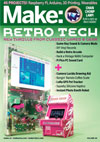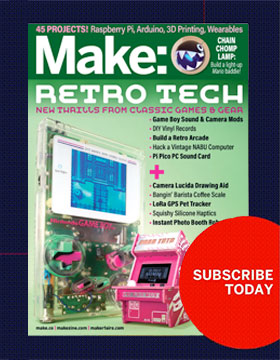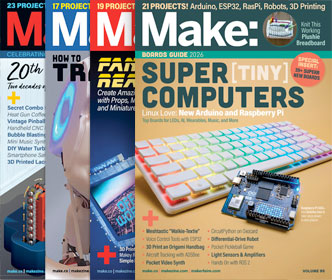
This week:
The Himawari Prototype, Embroidery with a Regular Sewing Machine, TonchiDot’s Sekai Camera, iphoneas, Tenori-Off, Plushie: An Interactive Design System for Plush Toys, squarewave surfers ~ memory of 8bit, Craftwife, Turning Chopsticks Into Hairpins – Using Cat Paws?, and the KikiMimi Audio Board Game.
Himawari Prototype
Akira Nakayasu brings us this cyborg sunflower. Here’s my translation of what the video description says:
It’s not a plant, not an animal, and not a robot (machine). Using an infrared camera inside the flower, the Himawari Prototype analyzes human movements and moves towards where there is movement. There are four servo motors in the stem, with three axes in the base and one axis on the flower. In the flower, there are 50 colored LEDs and infrared LEDs (for the infrared camera) and 60 pieces of shape memory alloy. Each one is independent and changes depending on the human movement.
Things get a little bit creepy at about 2:20. Those shape memory alloy strands look like wiggling bean sprouts.
Embroidery with a Regular Sewing Machine
DPZ shows us that you maybe don’t necessarily need one of those fancy computer-controlled embroidery machines to do quality embroidering. It turns out that it does, however, help to have some creativity, imagination, and a lot of patience.
TonchiDot’s Sekai Camera
One of the more talked about presentations at the recent TechCrunch50 conference was by team TonchiDot, which included MIJ interviewee Masayuki Akamatsu along with CEO Takahito Iguchi. Sekai Camera (“World” Camera) is an application that is in development for the iPhone that uses the phone’s screen as a means of showing tagged information about geographical points where the camera is pointed. Their presentation left quite a few people mystified, as it left quite a bit to be desired as far as explanation of the underlying technology behind this service (you can see for yourself in this very interesting video of the TonchiDot team’s Q&A at the conference). Regardless of their reasons for withholding details about the tech behind the project, this imaginative sci-fi-esque mobile application caught the attention of many attendees, and it will be interesting to check this out when they get it off the ground.
iphoneas
iphoneas is a library that allows you to use the iPhone to control Flash via OSC messages from the App Store-approved OSCemote. Your ability to pinch, pull out, and rotate is limited only by what your fat little sausage fingers can do.
Tenori-Off
Collin beat me to it! Oh well… Kentaro Fukichi created this hilarious, ingenious answer to the mega-popular (and hard-to-get) Tenori-On, cleverly titled the Tenori-Off. I think the picture here pretty much explains it all. This “unplugged” version of the Tenori-On can be made with some plastic piping, a piece of plexiglass, and some delicious bubble wrap. He’s even thinking of adding a contact mic and embedded LEDs in future revisions, so this thing will no doubt just keep getting better.
Plushie: An Interactive Design System for Plush Toys
Yuki Mori and Takeo Igarashi of the Research Center for Advanced Science and Technology at the University of Tokyo have developed this interactive 3D modeler for making plush toys.
We introduce Plushie, an interactive system that allows nonprofessional users to design their own original plush toys. To design a plush toy, one needs to construct an appropriate two-dimensional (2D) pattern. However, it is difficult for non-professional users to appropriately design a 2D pattern. Some recent systems automatically generate a 2D pattern for a given three-dimensional (3D) model, but constructing a 3D model is itself a challenge. Furthermore, an arbitrary 3D model cannot necessarily be realized as a real plush toy, and the final sewn result can be very different from the original 3D model. We avoid this mismatch by constructing appropriate 2D patterns and applying simple physical simulation to it on the fly during 3D modeling. In this way, the model on the screen is always a good approximation of the final sewn result, which makes the design process much more efficient.
Sorry Mac kids, it’s Windows-only for now.
squarewave surfers ~ memory of 8bit
A rocking event of sorts filled with gadgets that were never primarily made to be used as synthesizers (Gameboys, Famicoms, modded toys, etc.), was held inside a store during regular business hours. “But what about the loud noises?” you ask… It turns out that the sound level coming out of the speakers was nothing much to speak of, but the real rock was provided by pumping the sound out to blaringly loud headphones that were hooked up to Belkin RockStar Splitters. People were using the RockStar Splitter not just as a splitter, but as a mixer, mashing up several DS-10s, synth kits, and Theremins. This seems like a cool way to have shows in smaller places where noise complaints might be an issue. When all of the sound is coming out of direct outputs from various electronic instruments (instead of loud drums sets and amps), why not let the volume be pumped to the listener through alternate methods of delivery? [via Giz Japan]
Check it:
Craftwife
An homage to Kraftwerk consisting of an iPhone controlling SuperCollider played by an attractive woman? What is there not to like? Here we have a jailbroken iPhone communicating with SuperCollider via OSC using what may very well be one of Masayuki Akamatsu’s pre-App Store (now absent) iPhone music interface creations. This self-proclaimed SuperCollider girl seems to have kind of a weird obsession with SuperCollider, writing love songs for it and even passing out promotional tissue in support of this versatile, free music software. Her devotion is most endearing.
(Warning: The link above will make your browser shake all over the place for a few seconds. It will stop eventually, I promise.)
Turning Chopsticks Into Hairpins – Using Cat Paws?
Yeah, I suppose that internet DIY how-to videos have been around long enough that it takes a little something extra to make them stand out. How about demonstrating with cat paws how to turn an old chopstick into a decorative hair pin? Make: Japan posted this video of YouTube user zannaleeidees, whose how-to craft videos all happen to be executed with cat paws. Truly next-level, amazing stuff. Wow.
KikiMimi Audio Board Game
Kikimimi is a card game system for the visually impaired. The game is made up of transparent blocks that have IC tags inside them, and the accompanying reader boxes sense the tags and read the names of the blocks out loud. The system is not just limited to card games, there are several variations of programs that can be played, such as the game ZOO, in which the reader plays animal noises that correspond to the blocks, shown here:
4 thoughts on “Made in Japan – Volume 32”
Comments are closed.
ADVERTISEMENT
Join Make: Community Today

















cat paws – so inspiring/awesome!
how long ’til we see some ‘hulk hand’ how-tos?
That plush-creating software looks absolutely amazing!
Not to mention time-saving.